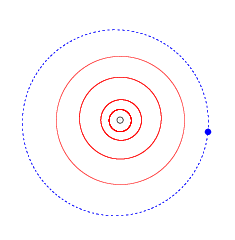 | |
| Discovery [1] | |
|---|---|
| Discovered by | DES |
| Discovery site | Kitt Peak National Obs. |
| Discovery date | 18 April 1999 |
| Designations | |
| (53311) Deucalion | |
| Pronunciation | /djuːˈkeɪliən, -ɒn/[2] |
Named after | Δευκαλίων Deukălĭōn[1] (Greek mythology) |
| 1999 HU11 | |
| TNO [3] · cubewano[4] cold [5] | |
| Adjectives | Deucalionean Deucalionian /djuːkæliˈoʊniən/ |
| Orbital characteristics [3] | |
| Epoch 27 April 2019 (JD 2458600.5) | |
| Uncertainty parameter 4 · 3[1] | |
| Observation arc | 15.04 yr (5,492 d) |
| Aphelion | 47.371 AU |
| Perihelion | 41.419 AU |
| 44.395 AU | |
| Eccentricity | 0.0670 |
| 295.81 yr (108,044 d) | |
| 307.41° | |
| 0° 0m 11.88s / day | |
| Inclination | 0.3720° |
| 51.363° | |
| 237.36° | |
| Physical characteristics | |
| 131 km (est.)[5] 212 km (est.)[6] | |
| 0.09 (assumed)[6] 0.20 (assumed)[5] | |
| 6.6[1][3] | |
53311 Deucalion /djuːˈkeɪliən/ (provisional designation 1999 HU11) is a trans-Neptunian object from the classical Kuiper belt, with a diameter of approximately 130–210 kilometers (81–130 miles), located in the outermost region of the Solar System. The cubewano belongs to the cold population and was discovered on 18 April 1999, by the Deep Ecliptic Survey at the Kitt Peak National Observatory in Arizona, United States. It was named after Deucalion, from Greek mythology.[1][6][5]
- ^ a b c d e Cite error: The named reference
MPC-objectwas invoked but never defined (see the help page). - ^ Noah Webster (1884) A Practical Dictionary of the English Language
- ^ a b c Cite error: The named reference
jpldatawas invoked but never defined (see the help page). - ^ Cite error: The named reference
Buiewas invoked but never defined (see the help page). - ^ a b c d Cite error: The named reference
Brown-dplistwas invoked but never defined (see the help page). - ^ a b c Cite error: The named reference
johnstonsarchive-TNO-listwas invoked but never defined (see the help page).